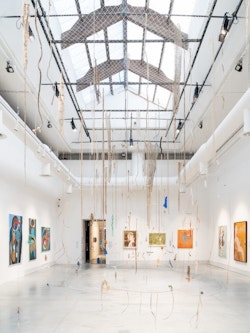Cecilia Vicuña in The Milk of Dreams
22 April—27 November 2022
Group exhibition at 59th International Art Exhibition, Venice Biennale, Venice, Italy
First produced during the artist’s exile following the violent CIA-supported and Pinochet-led military coup against Salvador Allende in early 1970s Chile, Cecilia Vicuña’s work is marked by a distinct feeling of transience, often expressed through abstract, ephemeral works made with found materials. In 1966, she began her still-ongoing project of anti-monumental constructions known as precarios. Often these sculptures are left untouched, exposed to the forces of weather and tides.

In new precarios such as NAUfraga (2022), composed of ropes and debris found around Venice, the power of Vicuña’s oppositional politics remains potent: taken from the Latin words navis (ship) and frangere (to break), NAUfraga suggests the exploitation of the Earth, which has caused Venice to slowly sink into the sea. Vicuña’s paintings evidence her indebtedness to Indigenous ways of thinking. Leoparda de Ojitos (1977) and La Comegente (1971) take inspiration from 16th century paintings by Incan artists in Cuzco, Peru, who were forced to convert to Catholicism and both paint and worship Spanish religious icons. In the fantastical Leoparda de Ojitos, the titular leopard stands between a pink and green tree in a coat of fur spotted with eyeballs, openly displaying her genitals. Expressive of a decolonial method of portraiture, Vicuña’s paintings rebel against the form by putting an Indigenous woman’s imagination at the centre.


